Synergistic Interaction of CPP2 Coupled with Thiazole Derivates Combined with Clotrimazole and Antineoplastic Drugs in Prostate and Colon Cancer Cell Lines
Abstract
:1. Introduction
2. Results
2.1. Cytotoxic Effect of CPP2–Thiazole Conjugates, Reference Drugs (PTX or 5-FU) and CLZ on HT-29 and PC-3 Cells
2.2. Cytotoxic Effect of Selected Combinations of CPP2–Thiazole Conjugates plus Reference Drugs (PTX or 5-FU) on HT-29 and PC-3 Cells
2.3. Cytotoxic Effect of Selected Combinations of CPP2–Thiazole Conjugates plus Repurposed Drug (CLZ) on HT-29 and PC-3 Cells
2.4. Cytotoxic Effect of Reference Drugs (PTX or 5-FU) plus the Repurposed Drug (CLZ) on HT-29 and PC-3 Cells
2.5. Morphological Analysis of HT-29 and PC-3 Cells Treated with CPP2–Thiazole Derivatives Both Alone and Combined
2.6. Evaluation of the Drug Interaction of Reference Drugs (PTX or 5-FU) and CLZ plus CPP2–Thiazole Derivatives on HT-29 and PC-3 Cells
3. Discussion
4. Materials and Methods
4.1. CPP2 and CPP2–Thiazole Conjugate Synthesis
4.1.1. Reagents and Solvents
4.1.2. Synthesis of CPP2
4.1.3. Synthesis of the NTZ-C2-CPP2 and MTZ-C2-CPP2 Conjugates
4.1.4. Synthesis of the BenzoTZ-C2-CPP2 Conjugate
4.1.5. Synthesis of the BTZCA-CPP2 and BTZ5CA-CPP2 Conjugates
4.1.6. General Analysis Procedure
4.2. Cell Culture
4.2.1. Materials
4.2.2. Cell Line and Cell Culture
4.2.3. Cell Culture Treatment
4.2.4. Cytotoxicity Assays
4.2.5. Cell Morphology Visualisation and Cell Count Analysis
4.2.6. Data Analysis
4.2.7. Analysis of Drug Interactions
4.2.8. Statistical Analysis
Author Contributions
Funding
Institutional Review Board Statement
Informed Consent Statement
Data Availability Statement
Acknowledgments
Conflicts of Interest
References
- Xie, J.; Bi, Y.; Zhang, H.; Dong, S.; Teng, L.; Lee, R.J.; Yang, Z. Cell-Penetrating Peptides in Diagnosis and Treatment of Human Diseases: From Preclinical Research to Clinical Application. Front. Pharmacol. 2020, 11, 697. [Google Scholar] [CrossRef] [PubMed]
- Gupta, B.; Levchenko, T.; Torchilin, V. Intracellular delivery of large molecules and small particles by cell-penetrating proteins and peptides. Adv. Drug Deliv. Rev. 2005, 57, 637–651. [Google Scholar] [CrossRef] [PubMed]
- Tripathi, P.P.; Arami, H.; Banga, I.; Gupta, J.; Gandhi, S. Cell penetrating peptides in preclinical and clinical cancer diagnosis and therapy. Oncotarget 2018, 9, 37252–37267. [Google Scholar] [CrossRef] [PubMed] [Green Version]
- Pooga, M.; Langel, Ü. Classes of Cell-Penetrating Peptides. In Cell-Penetrating Peptides: Methods and Protocols; Humana Press: New York, NY, USA, 2015; pp. 3–28. [Google Scholar]
- Derakhshankhah, H.; Jafari, S. Cell penetrating peptides: A concise review with emphasis on biomedical applications. Biomed. Pharmacother. 2018, 108, 1090–1096. [Google Scholar] [CrossRef] [PubMed]
- Guo, Z.; Peng, H.; Kang, J.; Sun, D. Cell-penetrating peptides: Possible transduction mechanisms and therapeutic applications. Biomed. Rep. 2016, 4, 528–534. [Google Scholar] [CrossRef] [PubMed] [Green Version]
- Milletti, F. Cell-penetrating peptides: Classes, origin, and current landscape. Drug Discov. Today 2012, 17, 850–860. [Google Scholar] [CrossRef] [PubMed]
- Wender, P.A.; Mitchell, D.J.; Pattabiraman, K.; Pelkey, E.T.; Steinman, L.; Rothbard, J.B. The design, synthesis, and evaluation of molecules that enable or enhance cellular uptake: Peptoid molecular transporters. Proc. Natl. Acad. Sci. USA 2000, 97, 13003–13008. [Google Scholar] [CrossRef] [PubMed] [Green Version]
- Mai, J.C.; Shen, H.; Watkins, S.; Cheng, T.; Robbins, P.D. Efficiency of protein transduction is cell type-dependent and is enhanced by dextran sulfate. J. Biol. Chem. 2002, 277, 30208–30218. [Google Scholar] [CrossRef] [PubMed] [Green Version]
- Verdurmen, W.P.R.; Brock, R. Biological responses towards cationic peptides and drug carriers. Trends Pharmacol. Sci. 2011, 32, 116–124. [Google Scholar] [CrossRef] [PubMed]
- Siegel, R.L.; Miller, K.D.; Jemal, A. Cancer statistics, 2020. CA Cancer J. Clin. 2020, 70, 7–30. [Google Scholar] [CrossRef] [PubMed]
- Agrawal, P.; Bhalla, S.; Usmani, S.S.; Singh, S.; Chaudhary, K.; Raghava, G.P.S.; Gautam, A. CPPsite 2.0: A repository of experimentally validated cell-penetrating peptides. Nucleic Acids Res. 2016, 44, D1098–D1103. [Google Scholar] [CrossRef] [PubMed]
- Yamada, T.; Das Gupta, T.K.; Beattie, C.W. P28, an anionic cell-penetrating peptide, increases the activity of wild type and mutated p53 without altering its conformation. Mol. Pharm. 2013, 10, 3375–3383. [Google Scholar] [CrossRef] [PubMed]
- Warso, M.A.; Richards, J.M.; Mehta, D.; Christov, K.; Schaeffer, C.; Rae Bressler, L.; Yamada, T.; Majumdar, D.; Kennedy, S.A.; Beattie, C.W.; et al. A first-in-class, first-in-human, phase I trial of p28, a non-HDM2-mediated peptide inhibitor of p53 ubiquitination in patients with advanced solid tumours. Br. J. Cancer 2013, 108, 1061–1070. [Google Scholar] [CrossRef] [PubMed]
- Kondo, E.; Saito, K.; Tashiro, Y.; Kamide, K.; Uno, S.; Furuya, T.; Mashita, M.; Nakajima, K.; Tsumuraya, T.; Kobayashi, N.; et al. Tumour lineage-homing cell-penetrating peptides as anticancer molecular delivery systems. Nat. Commun. 2012, 3, 951. [Google Scholar] [CrossRef] [PubMed]
- Duarte, D.; Fraga, A.G.; Pedrosa, J.; Martel, F.; Vale, N. Increasing the potential of cell-penetrating peptides for cancer therapy using a new pentagonal scaffold. Eur. J. Pharmacol. 2019, 860, 172554. [Google Scholar] [CrossRef] [PubMed]
- Duarte, D.; Cardoso, A.; Vale, N. Synergistic Growth Inhibition of HT-29 Colon and MCF-7 Breast Cancer Cells with Simultaneous and Sequential Combinations of Antineoplastics and CNS Drugs. Int. J. Mol. Sci. 2021, 22, 7408. [Google Scholar] [CrossRef] [PubMed]
- Duarte, D.; Vale, N. New trends for antimalarial drugs: Synergism between antineoplastics and antimalarials on breast cancer cells. Biomolecules 2020, 10, 1623. [Google Scholar] [CrossRef] [PubMed]
- Sharma, A.; Mehta, V.; Parashar, A.; Malairaman, U. Combinational effect of Paclitaxel and Clotrimazole on human breast cancer: Proof for synergistic interaction. Synergy 2017, 5, 13–20. [Google Scholar] [CrossRef]
- Chou, T.C. Drug combination studies and their synergy quantification using the chou-talalay method. Cancer Res. 2010, 70, 440–446. [Google Scholar] [CrossRef] [Green Version]
- Roell, K.R.; Reif, D.M.; Motsinger-Reif, A.A. An Introduction to Terminology and Methodology of Chemical Synergy—Perspectives from Across Disciplines. Front. Pharmacol. 2017, 8, 158. [Google Scholar] [CrossRef]
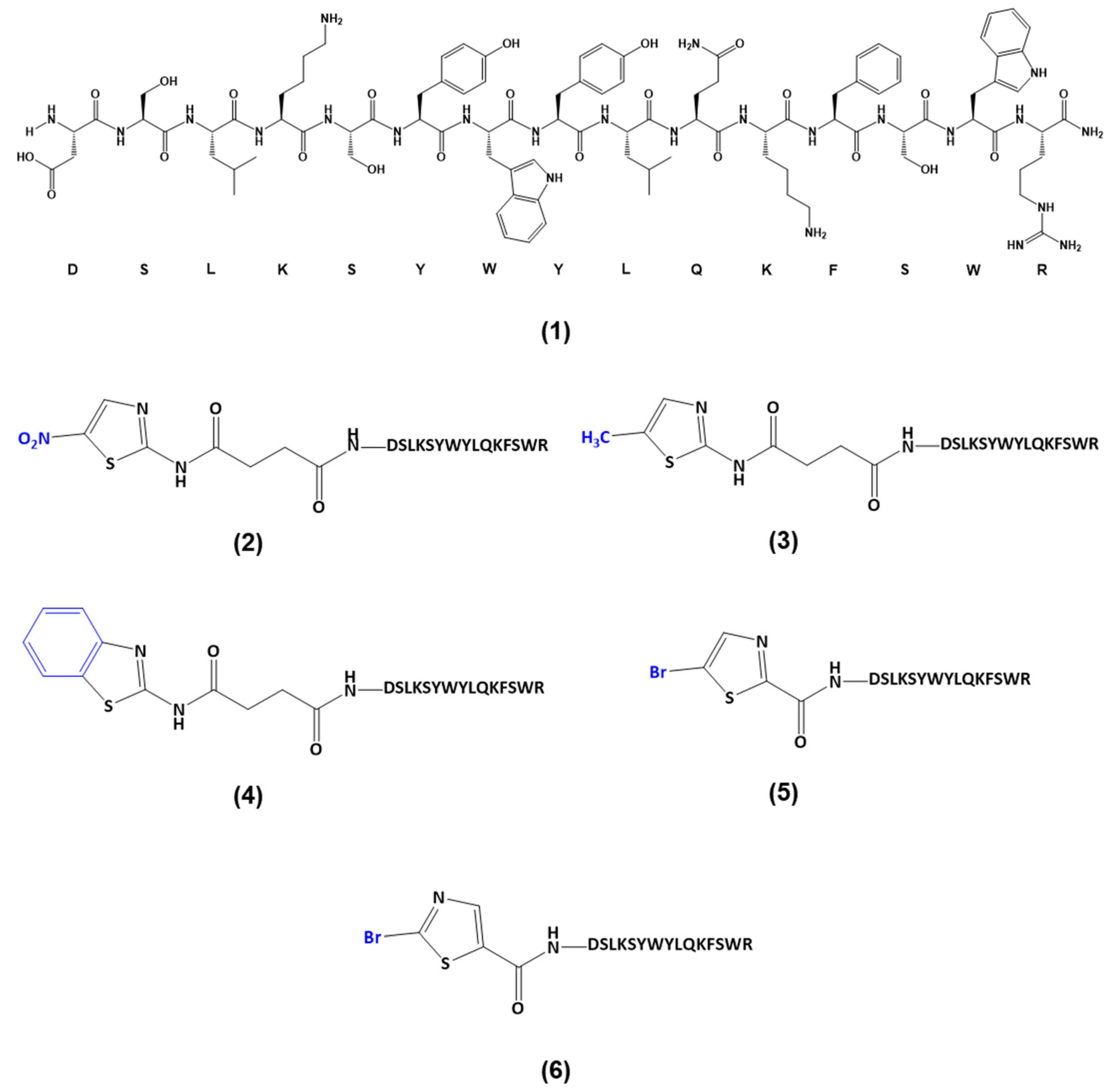
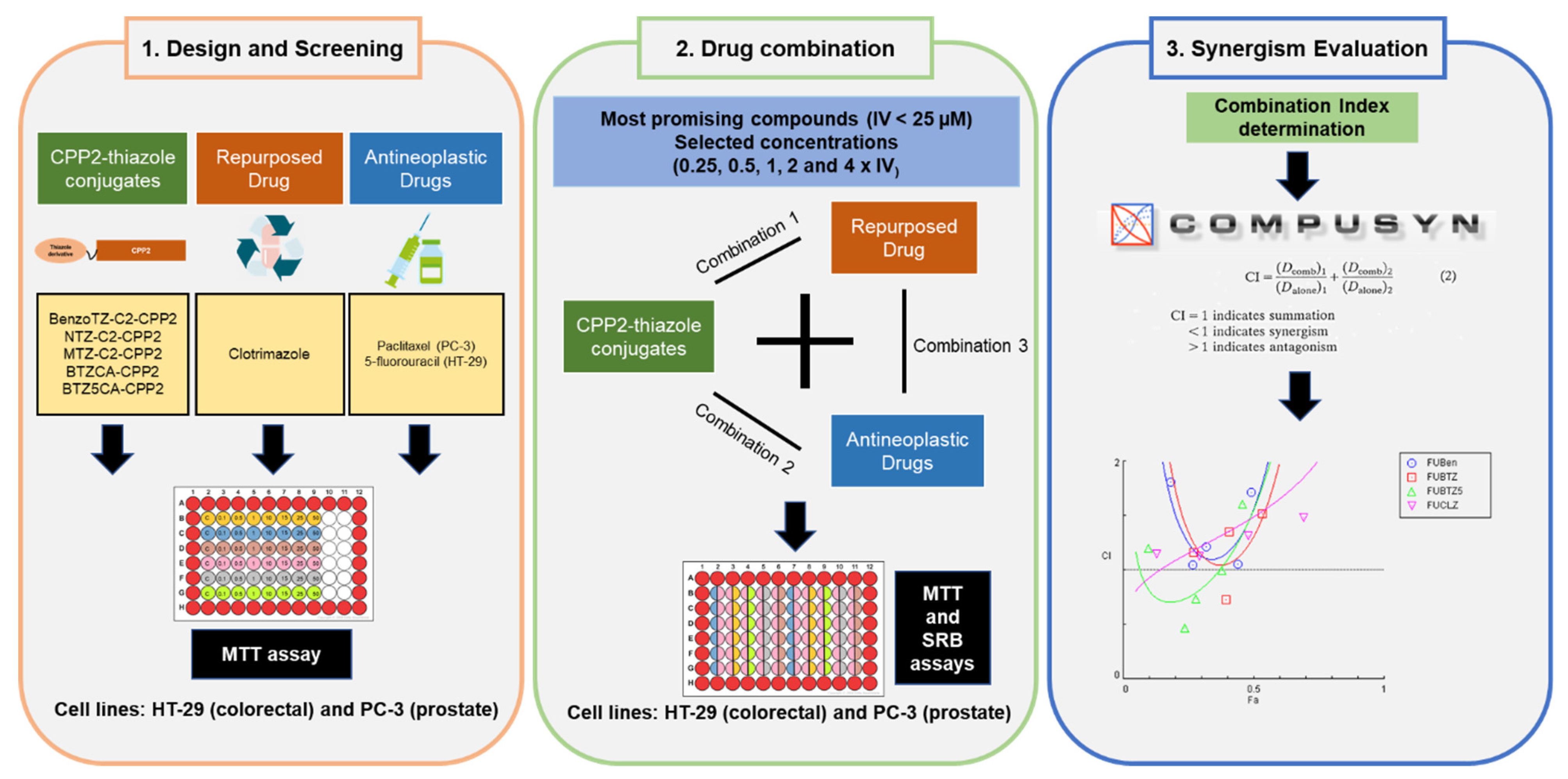
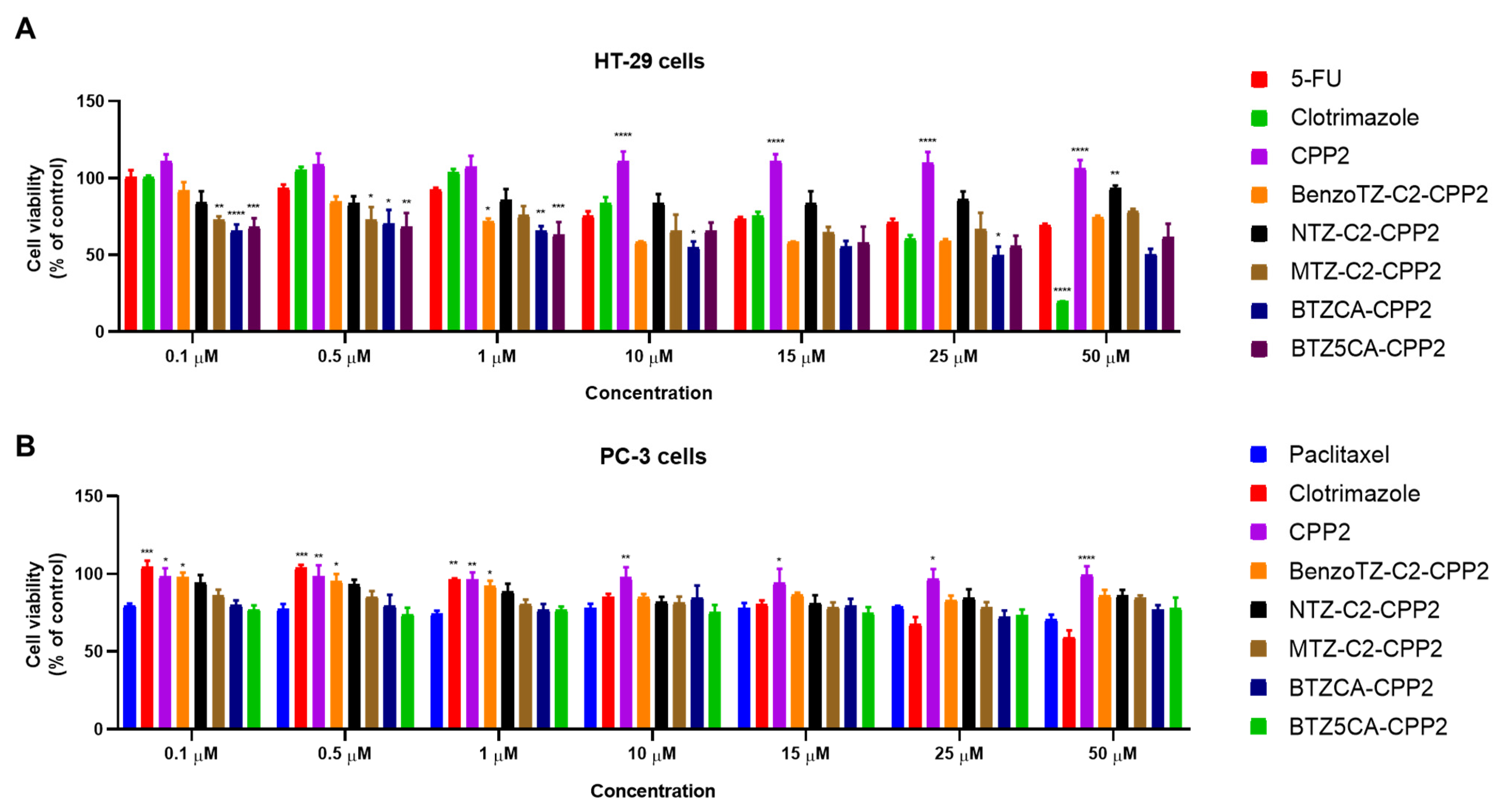

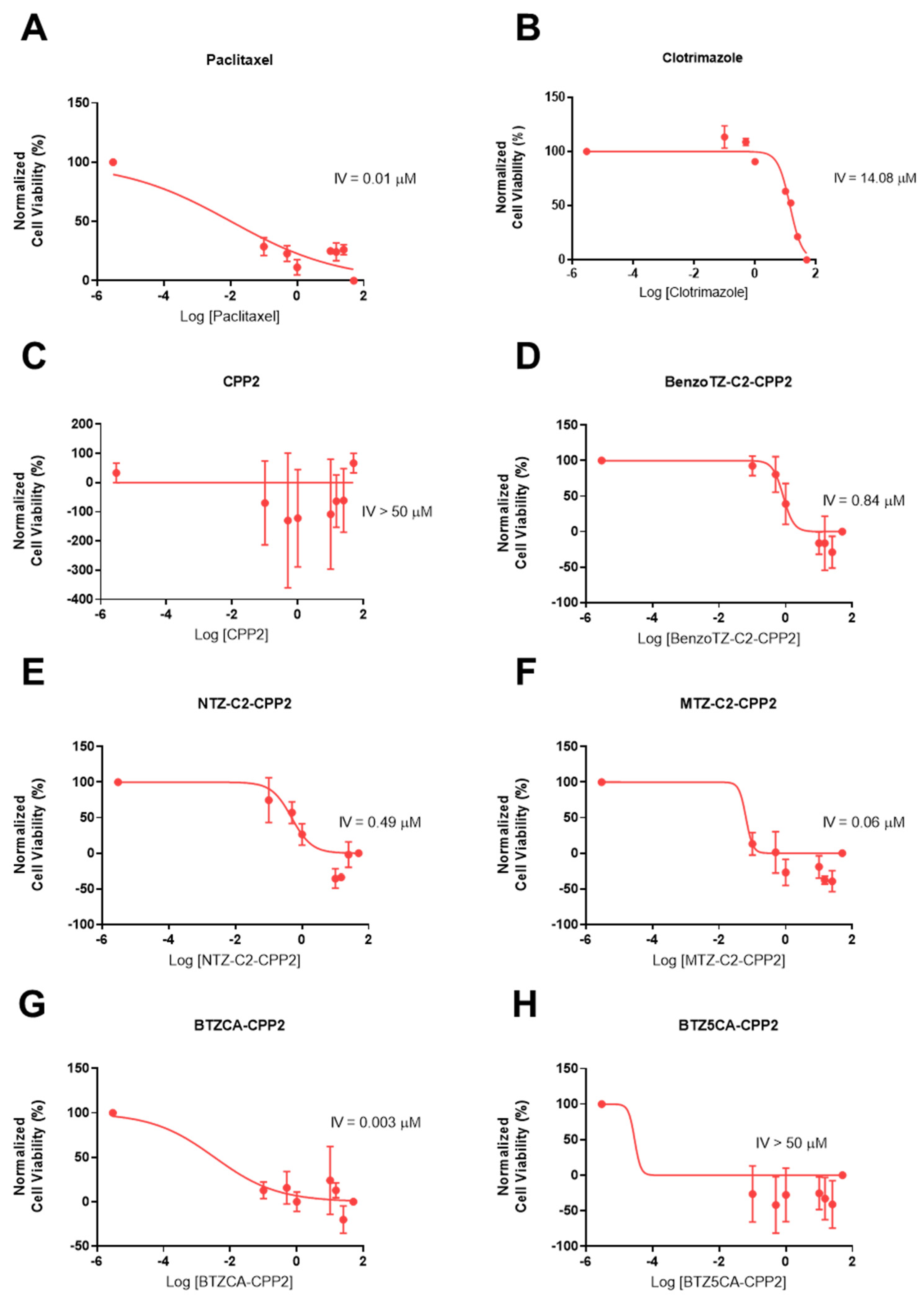
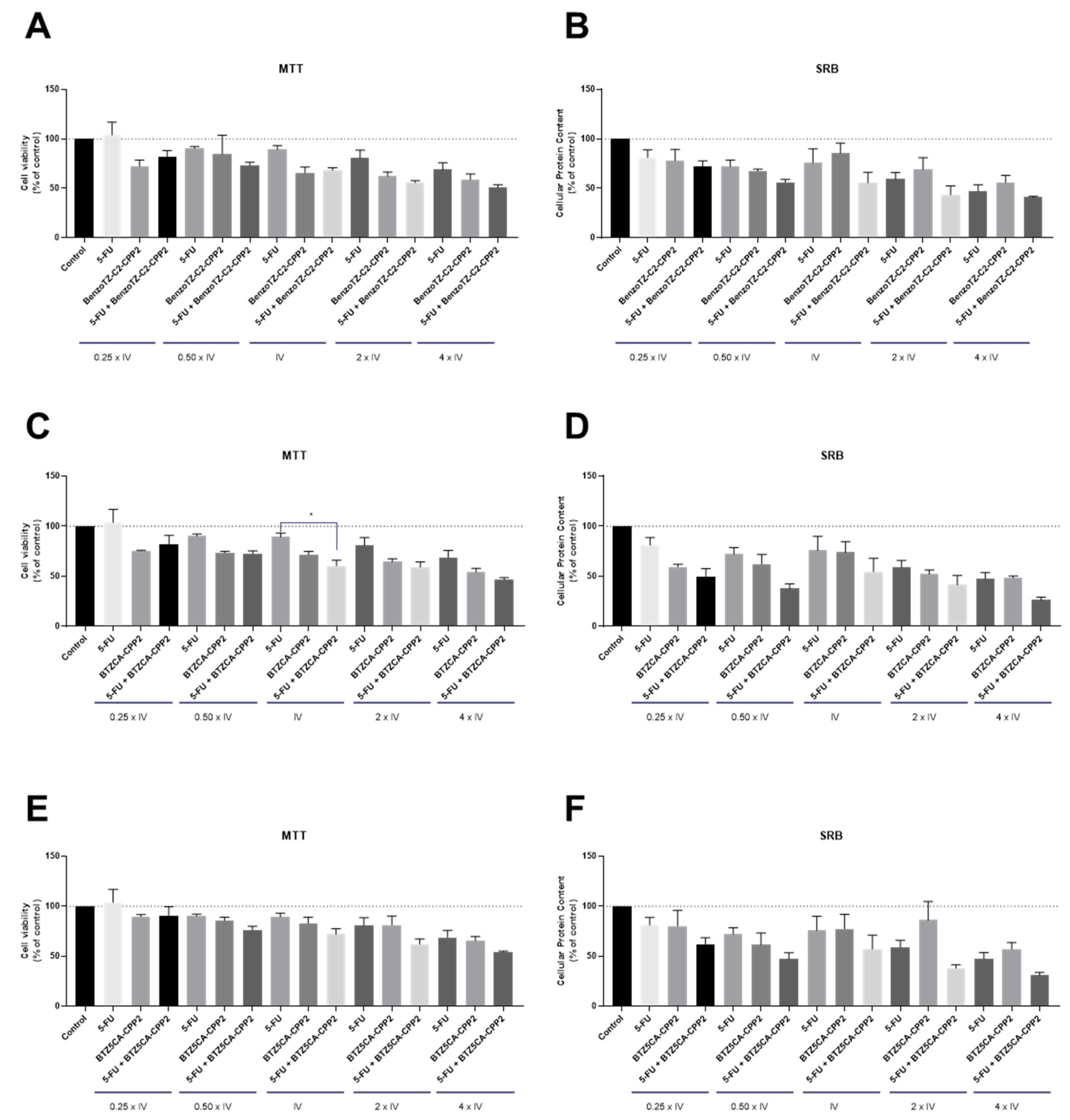
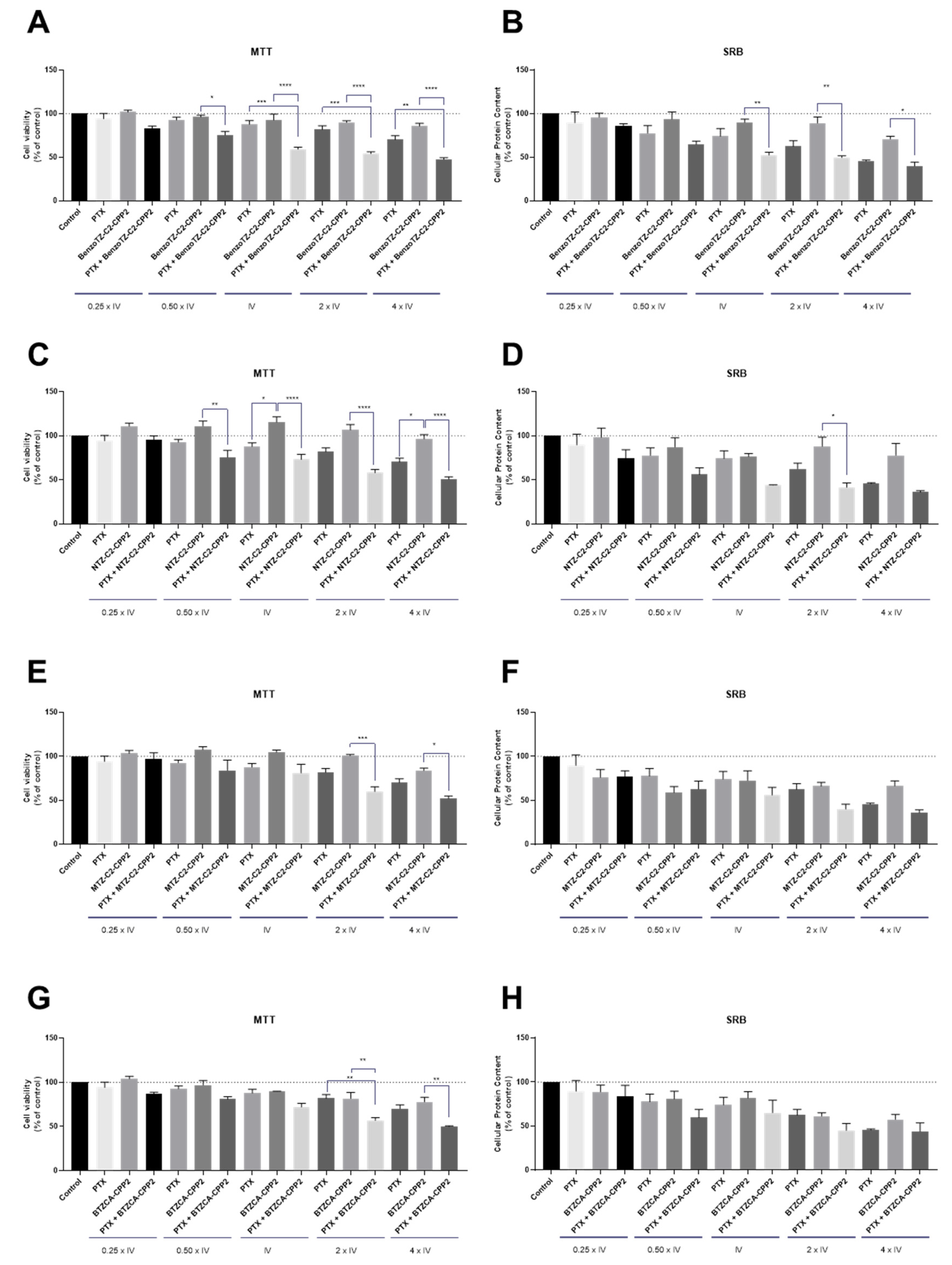
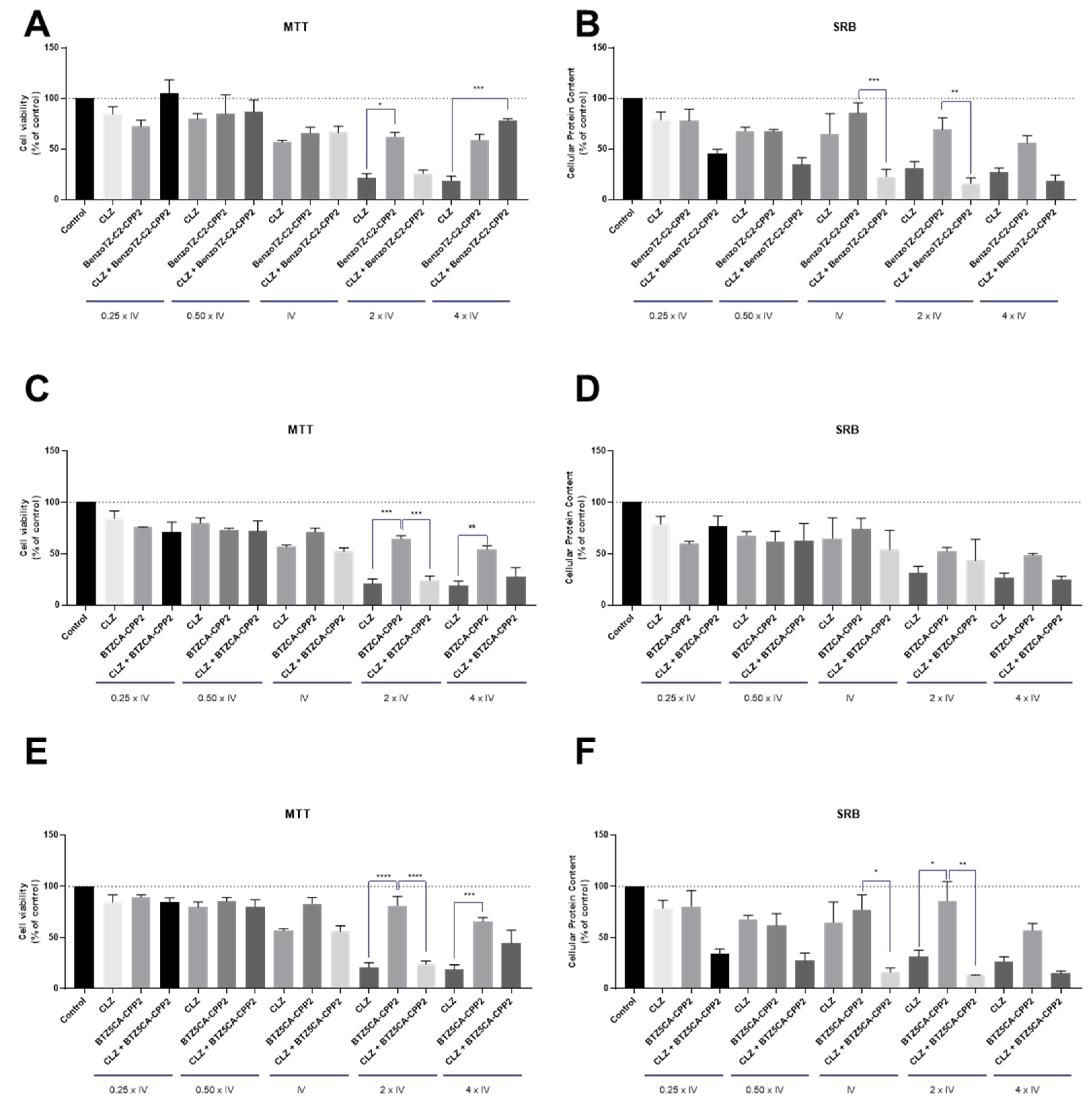
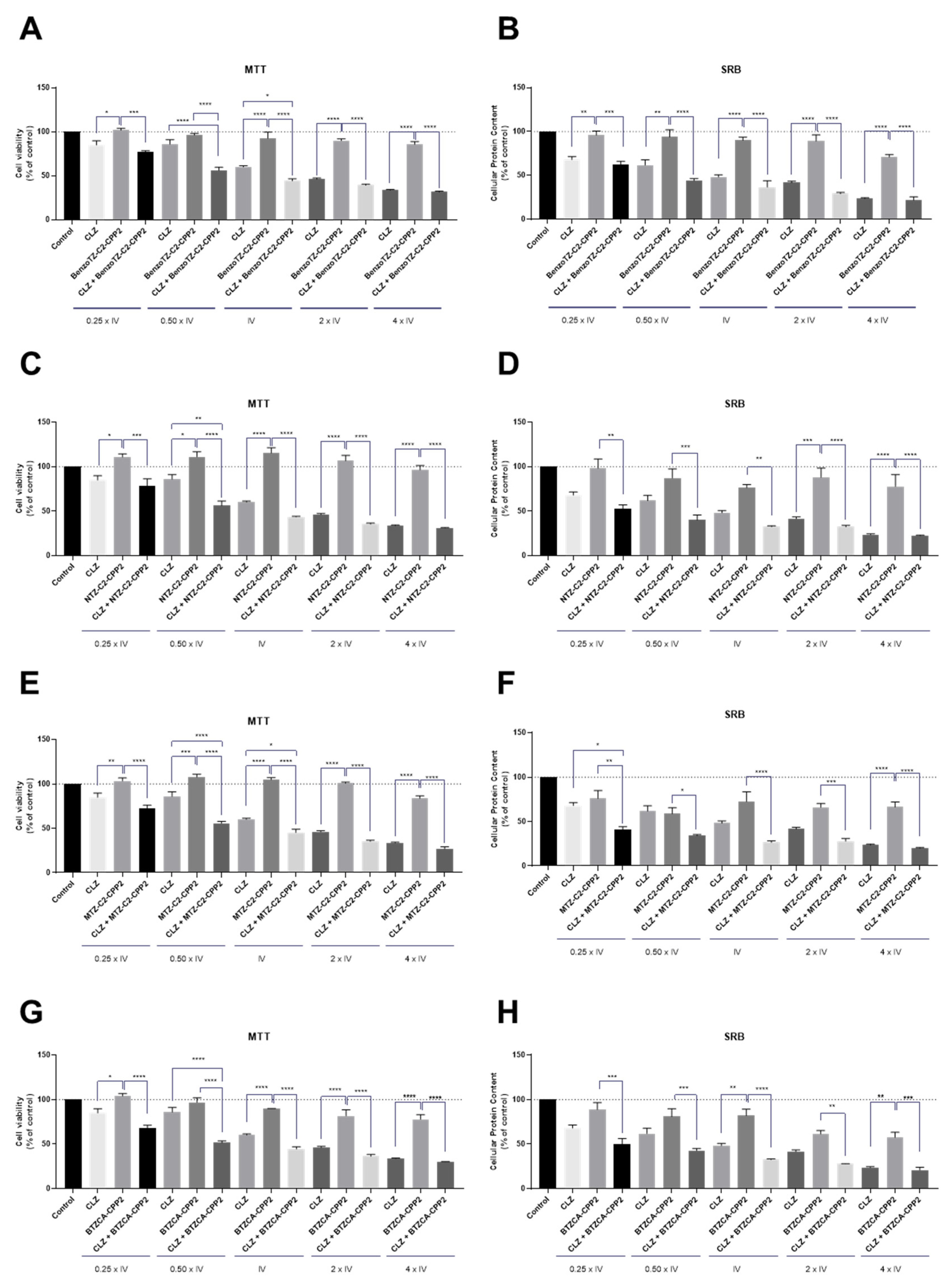
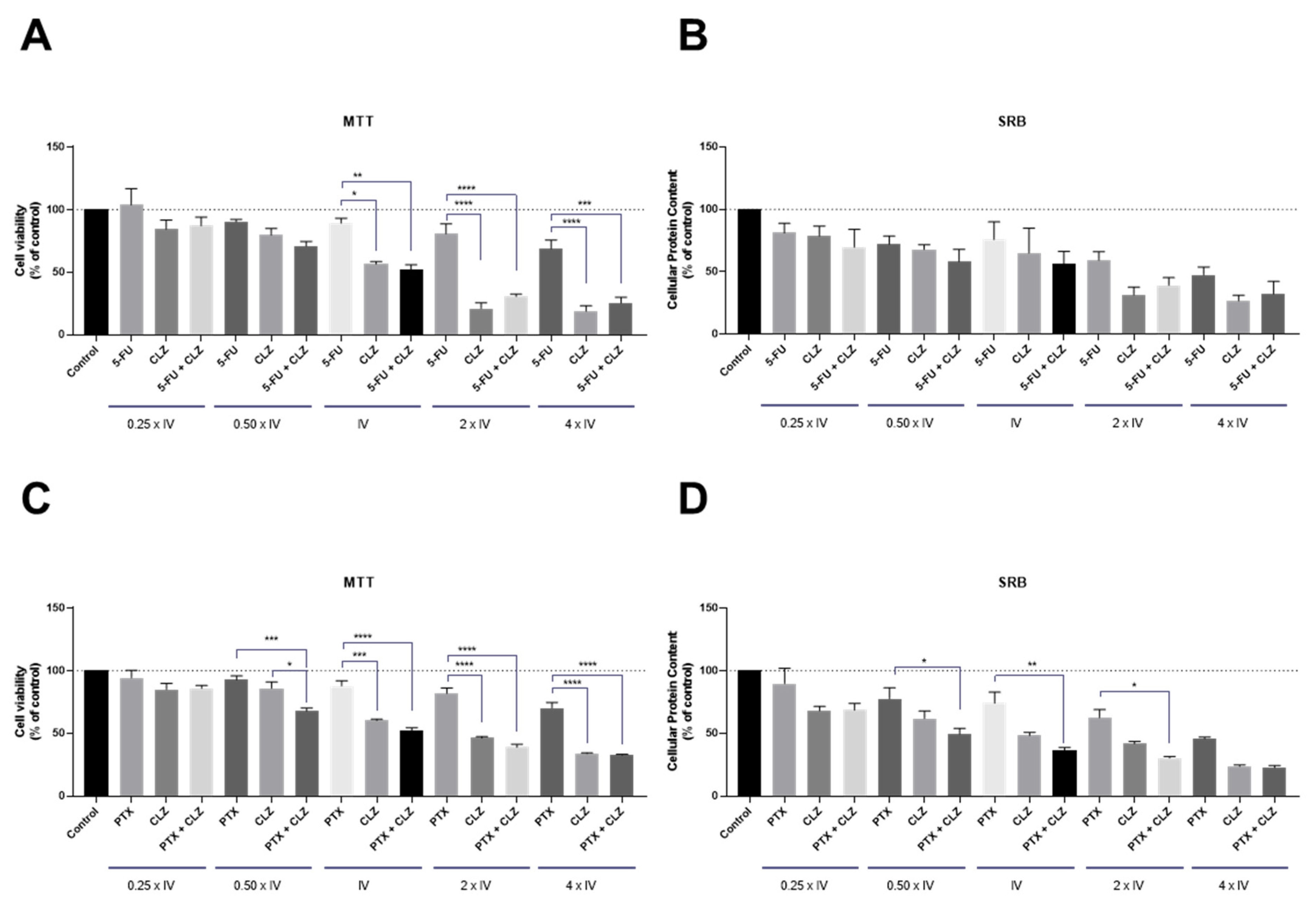


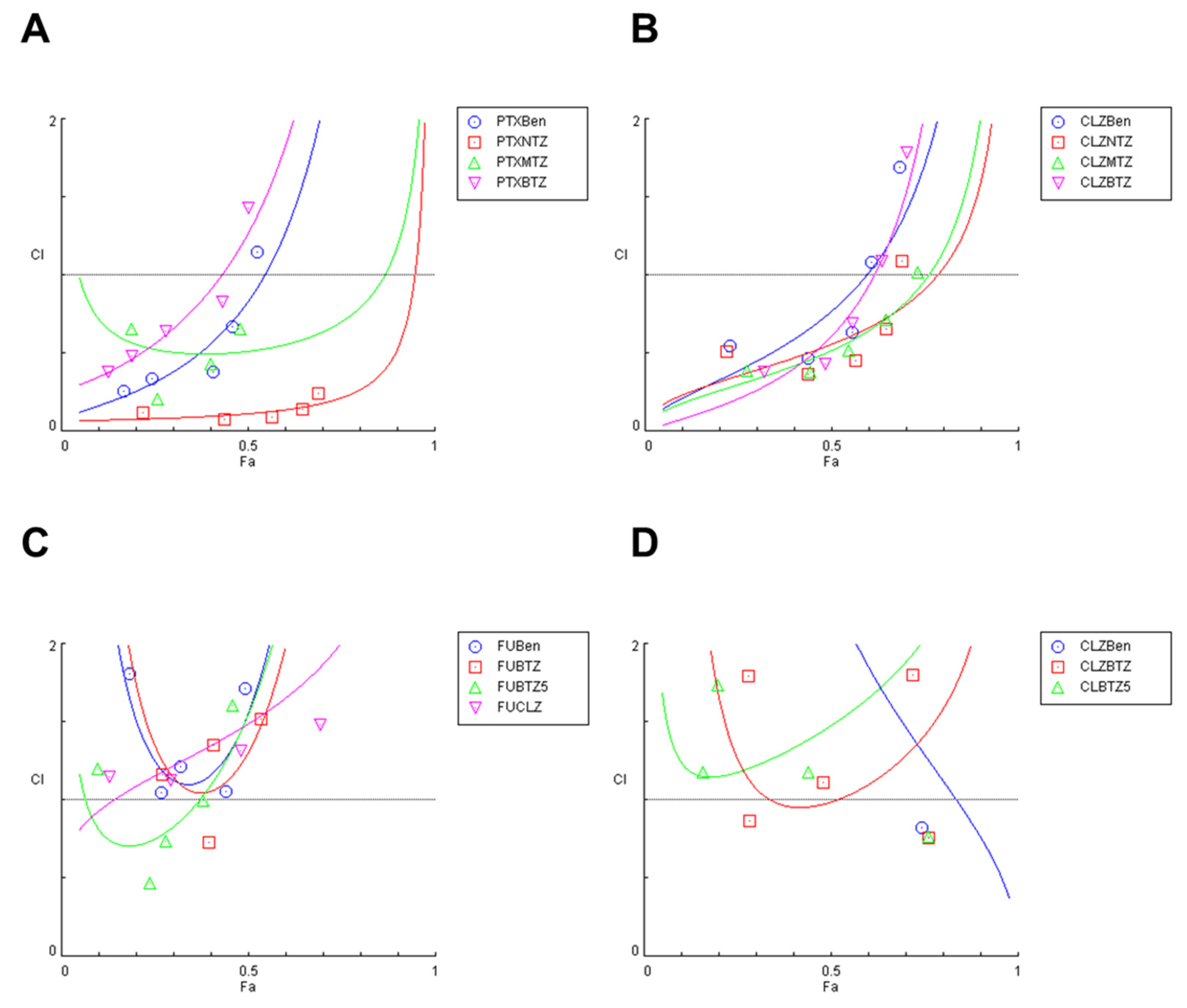
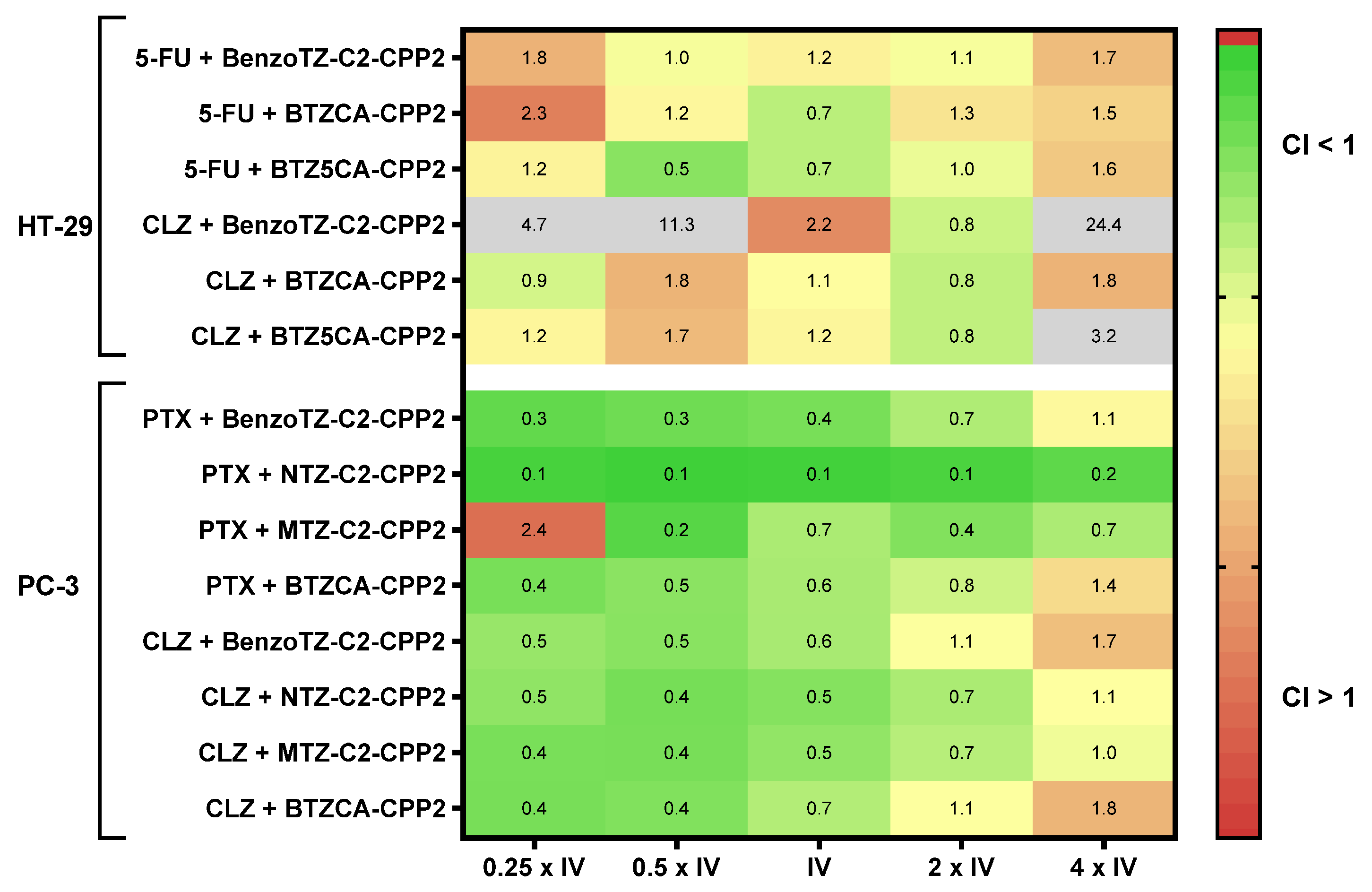
| Drug | HT-29 IV (µM) | PC-3 IV (µM) |
|---|---|---|
| 5-FU | 2.58 | ND |
| PTX | ND | 0.01 |
| Clotrimazole | 21.64 | 14.08 |
| CPP2 | >50 | >50 |
| BenzoTZ-C2–CPP2 | 0.21 ⁑ | 0.84 ⁑ |
| NTZ-C2–CPP2 | >50 | 0.49 ⁑ |
| MTZ-C2–CPP2 | >50 | 0.06 ⁑ |
| BTZCA–CPP2 | 0.05 ⁑ | 0.003 ⁑ |
| BTZ5CA–CPP2 | 0.01 ⁑ | >50 |
Publisher’s Note: MDPI stays neutral with regard to jurisdictional claims in published maps and institutional affiliations. |
© 2021 by the authors. Licensee MDPI, Basel, Switzerland. This article is an open access article distributed under the terms and conditions of the Creative Commons Attribution (CC BY) license (https://creativecommons.org/licenses/by/4.0/).
Share and Cite
Duarte, D.; Vale, N. Synergistic Interaction of CPP2 Coupled with Thiazole Derivates Combined with Clotrimazole and Antineoplastic Drugs in Prostate and Colon Cancer Cell Lines. Int. J. Mol. Sci. 2021, 22, 11984. https://doi.org/10.3390/ijms222111984
Duarte D, Vale N. Synergistic Interaction of CPP2 Coupled with Thiazole Derivates Combined with Clotrimazole and Antineoplastic Drugs in Prostate and Colon Cancer Cell Lines. International Journal of Molecular Sciences. 2021; 22(21):11984. https://doi.org/10.3390/ijms222111984
Chicago/Turabian StyleDuarte, Diana, and Nuno Vale. 2021. "Synergistic Interaction of CPP2 Coupled with Thiazole Derivates Combined with Clotrimazole and Antineoplastic Drugs in Prostate and Colon Cancer Cell Lines" International Journal of Molecular Sciences 22, no. 21: 11984. https://doi.org/10.3390/ijms222111984
APA StyleDuarte, D., & Vale, N. (2021). Synergistic Interaction of CPP2 Coupled with Thiazole Derivates Combined with Clotrimazole and Antineoplastic Drugs in Prostate and Colon Cancer Cell Lines. International Journal of Molecular Sciences, 22(21), 11984. https://doi.org/10.3390/ijms222111984







